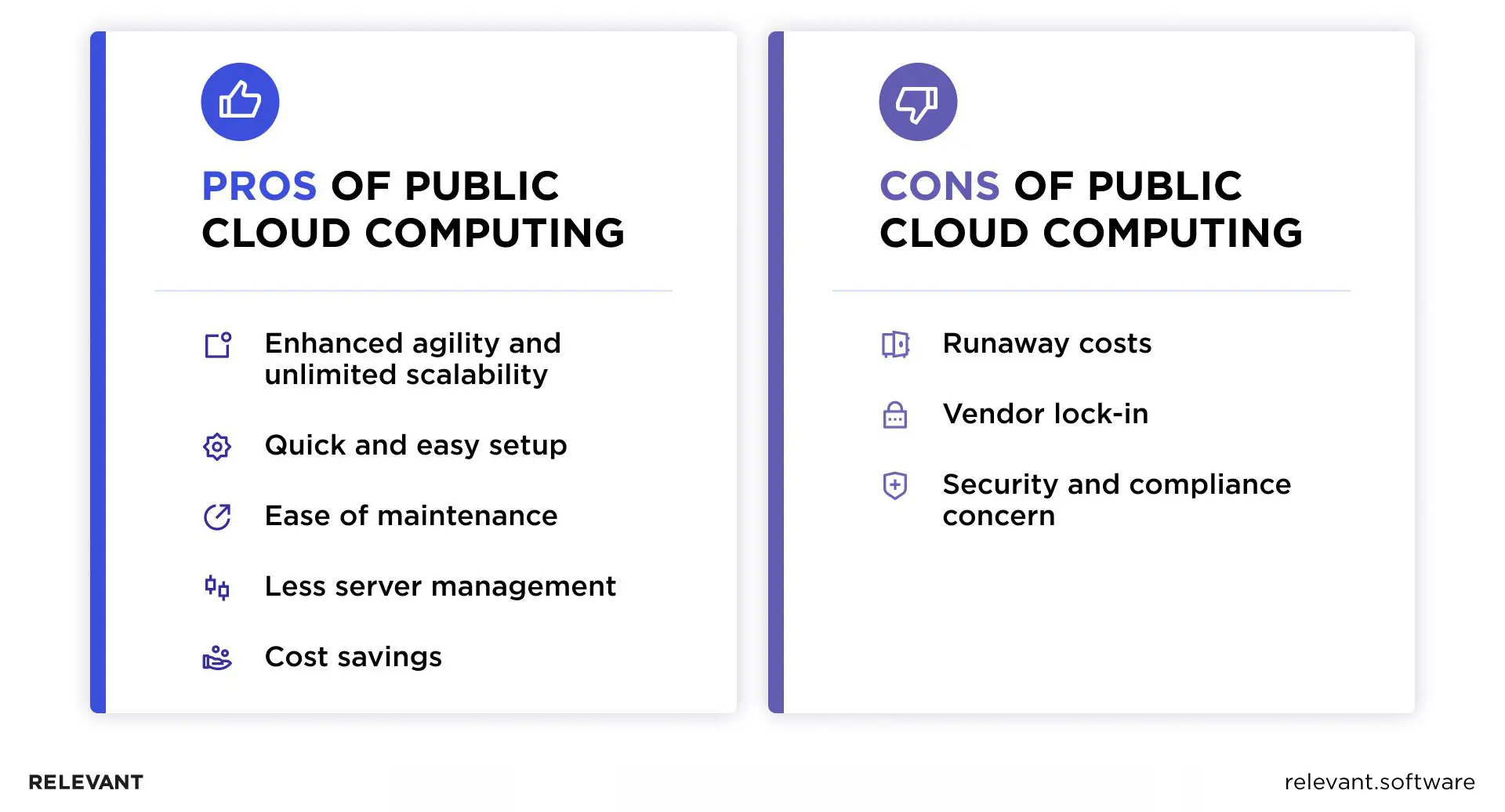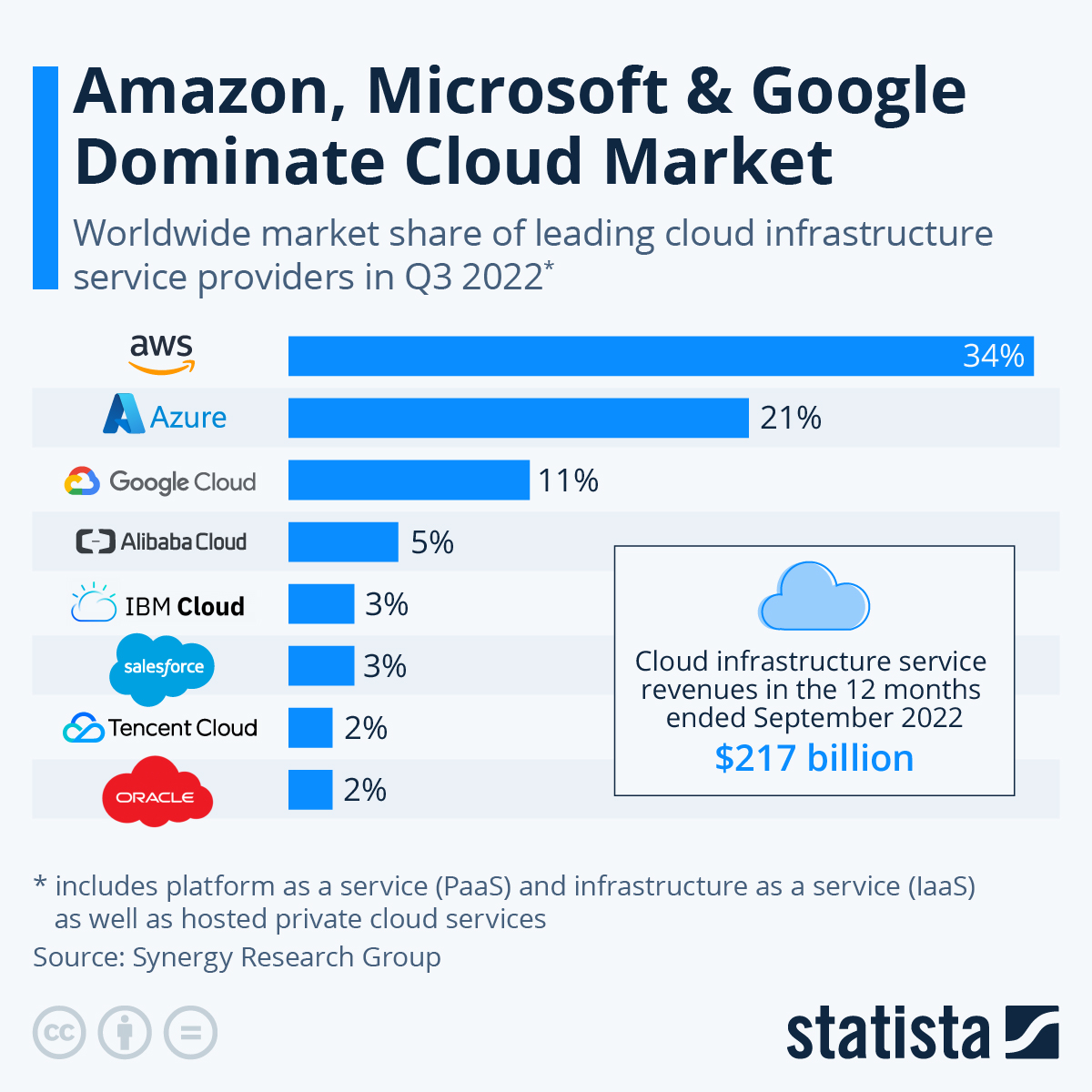Public Cloud Services in 2023: Benefits, Limitations, and Pricing

Public cloud services are a great way to get your business up and running quickly. They offer the flexibility and scalability you need to meet the demands of your growing company without having to invest in expensive hardware or software. These are just some of the reasons why the public cloud market is expected to reach $800 billion in revenue by 2025.
But before you sign up for a public cloud service, it’s important to understand what it can do for you and how it will work with your business. This article will explore the benefits, limitations, and pricing of public cloud services.
What Is a Public Cloud?
The public cloud is a computing resource delivery model offered by third-party providers, according to which these resources are shared between multiple companies via the Internet, and each of the companies can use as much computing power as they need, following a pay-as-you-go approach. The public cloud is one of three main cloud computing models available today, along with private and hybrid clouds.
Many businesses choose managed public cloud services because they can save money on hardware and software costs, as well as other expenses related to running a data center. Public clouds also provide security and cloud disaster recovery services at no additional cost. Another benefit of the public cloud is that the whole infrastructure is managed by the provider, which is also responsible for ensuring data security and compliance.
How Does the Public Cloud Work?
The public cloud is a technology that allows companies to store their data on a remote server. Instead of storing it on-premise, the business can store it in the cloud. It works by giving you access to a remote server. The server is hosted by a company like Amazon Web Services, Google Cloud, or Microsoft Azure that offers virtual machines that can be used by anyone who has subscribed for a service.
With a public cloud, the company can access its data from anywhere, and it’s stored in the same way your email is stored in Gmail: you can access a web-based interface that acts as a gateway to your files.
Public Cloud Architecture
If you’re considering migrating to the public cloud, it’s important to understand that there are three types of cloud architecture. Each type has its own advantages and disadvantages, so you have to choose one that meets your needs. These are Infrastructure as a service (IaaS), Platform as a Service (PaaS), and Software as a Service (SaaS). Let’s review each of them in more detail.

Infrastructure as a service (IaaS)
The first type is infrastructure as a service (IaaS). IaaS provides you with virtual machines that you can use to run applications on. It also includes storage, networking, and database services. The benefit of IaaS is that it gives you complete control over the virtual machine. This means that if something goes wrong with one of your servers, you can fix it yourself without having to wait for help from a cloud provider’s staff. The downside of IaaS is that it can be expensive if you need lots of resources or if your company needs high-performance infrastructure.
Platform as a service (PaaS)
PaaS gives developers everything they need to build and run their applications without worrying about managing servers or databases themselves. PaaS also includes development tools like IDEs and version control systems, so developers don’t have to spend time setting these up themselves, either. This model is great for startups who want to get started quickly and avoid setting up their own servers and infrastructure.
Software as a service (SaaS)
The third type is a software as a service (SaaS). SaaS gives users access to enterprise-level software through the cloud instead of installing it on their own machines. Software as a service (SaaS) gives users access to software applications that they can use right away, with no setup or maintenance required on their part. This model works best for businesses that want something simple but powerful that doesn’t require much maintenance.
Public Cloud vs. Private Cloud vs. Hybrid Cloud
Using a public cloud service isn’t the only option to optimize data storage costs and protect your data. There are also private and hybrid clouds, and depending on the use case, each of them comes with its benefits and possible drawbacks.

Public Cloud
Public cloud computing is a model of IT that offers shared resources, applications, and services to multiple customers over the internet. This includes the use of virtualization, web services, and storage platforms that can be accessed via the internet. Public cloud providers offer various types of virtual machines (VMs) for customers to use in their software development lifecycle (SDLC).
Private Cloud
Private cloud computing is an extension of on-premises infrastructure, where a company owns the physical servers and other equipment used in its data center. A private cloud allows companies to manage their own IT infrastructure without relying on an external provider for access or management purposes. This gives companies complete control over their data center resources, including power management, security policies, etc.
Hybrid Cloud
A hybrid approach involves using both public and private clouds as part of an enterprise IT strategy. Hybrid clouds allow you to combine the best features from both models – you get the security of a private cloud while still staying flexible as with a public cloud. However, hybrid cloud solutions are more expensive than either type of cloud alone because they require additional staff and resources to manage all the different parts.
Public vs. private vs. hybrid cloud – a comparison chart
Below is the comparison of public, hybrid, and private cloud models according to their cost, performance, scalability, and security features.
| Public cloud | Private cloud | Hybrid cloud | |
| Performance | Medium to high performance; depending on the provider | High-performance | High-performance |
| Security | Less secure compared to private and hybrid, but the security level largely depends on the provider | The most secure option | Less secure than a private but more secure than a public cloud |
| Scalability | High scalability | Scalability can be limited | High scalability |
| Cost | The most affordable option if you choose the right service model | The most expensive option | The cost of a hybrid cloud is usually reasonable – it costs more than a private but less than a public cloud |
Benefits of Public Cloud Computing
57% of businesses globally have already migrated their business processes to the managed public cloud, leveraging the benefits it comes with. Let’s find some of them below.

Ease of maintenance
One of the major benefits of public cloud computing is that it’s easy to maintain. When you use a public cloud service, you don’t have to worry about maintaining the hardware or keeping up with updates—the cloud provider will take care of all of that for you. You can just focus on getting your work done and let them worry about keeping things running smoothly.
Enhanced agility and unlimited scalability
Another benefit is enhanced agility and unlimited scalability. Public Cloud Computing allows you to scale up or down at any time. So, if your business needs a temporary boost in resources (for example, during a major marketing campaign), you can easily get those resources without having to buy new hardware for it since scaling happens behind the scenes.
Quick and easy setup
Public cloud computing allows users to quickly set up new servers without having to purchase hardware or configure physical infrastructure. This makes it ideal for startups that need to rapidly scale up their operations. The only thing you have to do is to choose a public cloud service provider and get in touch with a reliable tech vendor for cloud implementation services.
Less server management
When you’re running your own servers, you have to do all the work yourself. You have to figure out how to set up servers, how to manage them, and how to keep them running smoothly. With public cloud computing, you don’t have to worry about any of that—you just sign up for an account with a provider like Amazon Web Services or Microsoft Azure and then pay for what you use (and only for what you use). That way, if your business grows or shrinks over time, it’s much easier to adapt.
Cost savings
Public cloud computing also has another benefit: it’s cheaper than private cloud computing. With public cloud computing, there are no upfront costs for equipment or maintenance fees because everything runs on a shared network of computers instead of just one computer that belongs solely to you. What’s more, each of the cloud service providers we have reviewed above offers different and flexible engagement models, which means that you can choose a package that suits your business best right now and then scale step-by-step.
Drawbacks of Public Cloud Computing
In addition to the benefits, a public cloud has limitations. However, you can overcome most of them by choosing a trustworthy cloud service provider and having clear cloud adoption and migration strategies.
Runaway costs
There are a few drawbacks to public cloud computing, but the biggest one is runaway costs. When you’re using the public cloud, you have to pay for every single hour that your application runs. This means that if you need to scale your application up or down based on demand, it can get very expensive very quickly. That’s why you have to be especially careful when choosing between a pay-as-you-go model and a fixed subscription fee.
Security and compliance concern
Another possible issue with the public cloud is security and compliance concerns. Many businesses don’t feel safe storing their data with a third party, so they prefer not to use public clouds at all. But even if you are sure your cloud provider will not leak your data or compromise its security, there are still lots of regulations that apply to specific industries (for example, HIPAA compliance is a must for healthcare). Legal compliance requirements sometimes make it difficult to keep up with regulations while using a public cloud service.
Vendor lock-in
A vendor lock-in is an inability to move your data to another cloud provider. If you’re locked into one vendor, that means you can’t easily switch to another cloud provider since such a data migration project may cost a fortune. Sometimes, your business demands can also go beyond the public cloud capabilities your provider can offer. To avoid vendor lock-in, some companies choose to use multiple public cloud service providers, distributing their business processes and data among them.
Тop 5 Public Cloud Providers
Below are the top providers of public cloud-managed services. While Amazon, Microsoft, and Google capture the largest IaaS market share, according to Gartner, these aren’t the only companies to choose on the way to your cloud adoption.

Amazon Web Services (AWS)
Amazon Web Services (AWS) is a public cloud provider that offers its services through a global network of edge locations. The company provides a wide range of products and services, including computing, networking, storage, database, analytics, application services, and IoT connectivity. AWS also offers consulting and technical support services for its products.
Microsoft Azure
Microsoft Azure is a public cloud platform and infrastructure for building, deploying, and managing applications and data. The company’s IaaS allows users to rent virtual servers for running applications and storing data, as well as storage space for keeping their own data. Amazon also provides other cloud computing services, including database hosting, development tools, analytics, business intelligence software, content delivery network (CDN), and load balancing.
Google Cloud Platform
Google Cloud Platform (GCP) is a public cloud platform developed by Google. GCP offers infrastructure as a service, platform as a service, and software as a service. It supports a suite of integrated services for computing, analytics, and other applications that are hosted on Google’s infrastructure. The company’s global network of data centers has been designed to support mission-critical applications for companies of all sizes. GCP is built on open-source technology and uses standard APIs to help developers build, test, deploy and scale their solutions on Google’s infrastructure. Find out more about GCP by applying for our Google Cloud Platform consulting services.
Alibaba Cloud
Alibaba Cloud is the third-largest public cloud service provider worldwide. It offers infrastructure as a service (IaaS) solutions that include virtual machines (VMs), storage services, and platform as a service (PaaS) solutions. The company is committed to building a cloud ecosystem that meets the various needs of its customers – from the data center to edge computing and IoT development. It also provides various public services, including security, database services, big data analysis, and artificial intelligence.
IBM Cloud
IBM Cloud is a global cloud provider that offers a comprehensive portfolio of cloud services and solutions. IBM Cloud operates on an open architecture that allows you to use existing tools and skills or to build new ones. It’s designed with security in mind, and it meets industry standards for data protection, compliance, and governance. The provider offers a suite of cloud services that include AI, cloud computing and analytics, IoT, mobile, security, and blockchain.
What Is the Cost of Running Public Cloud Storage
As with custom software development, the only right answer to the question of the public cloud storage running cost is “it depends”. The cost of using a public cloud depends on the type of services you need. If you’re just looking for a place to store your data, there are many free options available. If your needs are more complex and require more resources, there are also many paid options at different price points.
The pricing model you will follow also matters significantly. Some public clouds are sold on a pay-as-you-go basis, so you only pay for what you use. The provider can also charge you per hour or per month, depending on your usage patterns. There are also tiered pricing plans, where you pay more for higher levels of service or resources. The mix of the options above is also possible.
So, the best way to find out how much it will cost you is to review the provider’s website or speak with their sales team directly. Leading cloud providers also have pricing calculators on their websites. With their help, you can get a clear idea of how much running a public cloud will cost in your specific case. To get a realistic picture, you must specify the expected workload, the necessary computing power, and the request processing time. So, depending on the provider you choose, you can use the dedicated calculators:
- Google Cloud Platform Pricing Calculator
- Microsoft Azure’s Pricing Calculator
- IBM Bluemix’s calculator
- Amazon AWS Pricing Calculator
- Alibaba Cloud Calculator
How Does Relevant Help Organizations That Use Public Clouds?
If you are now at the very beginning of your cloud adoption path, you are at the right place. We would be happy to help you with the next move by providing cloud consulting and cloud migration services, delivered by our tech-savvy developers, DevOps engineers, and Business Analysts. Together, they will help you choose the right public cloud service provider, develop a cloud migration strategy, classify and structure your data, and finally move your operations and workflows to the cloud.
Those companies eager to get started with modern cloud-based application development are welcome to reach out as well. We have already served over 200 customers worldwide, leveraging the latest technologies and cloud solutions to make their projects happen.
Bottom Line
Using a public cloud service is a wise choice for businesses eager to get more out of their data, saving costs along the way. They are also great for developers, who can spend more time working on their app and less time worrying about server management. And as you can see, there are many benefits to using this kind of service—which means that it’s an excellent choice for your business, too.
Make the first step to public cloud adoption by sending us a quick note, and our cloud experts will reach back to you shortly!



